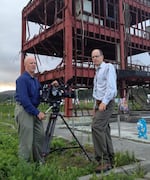
Oregon Field Guide producer Ed Jahn, right, with Oregon Public Broadcasting videographer Todd Sonflieth in front of the destroyed disaster prevention building in Minamisanriku, Japan, 2014. The building was destroyed during the March 11, 2011 earthquake and tsunami in that region.
OPB
Scientists say there's a 1-in-3 chance a magnitude 8 or 9 Cascadia Subduction Zone earthquake will hit the Pacific Northwest in the next 50 years. It's almost hard to exaggerate the destruction that a quake and a resulting tsunami could cause, especially for coastal communities, and especially if residents remain unprepared.
Oregon Field Guide producer Ed Jahn spent more than a year making the documentary "Unprepared." It looks at Oregon's preparedness, and finds the state lags far behind many quake-prone regions of the world. Ed Jahn spoke with OPB All Things Considered host Kate Davidson about making the film.
Q&A with Ed Jahn
Kate Davidson: Earthquakes aren't unheard of in the Northwest. Why did you focus on the risk from the Cascadia Subduction Zone?
Ed Jahn: I think a lot of people in the Northwest have said, "Oh, we've had earthquakes before. We had Nisqually. We've had ones in Klamath Falls and the Spring Break Quake." And they think that, "Oh, it's no big deal." Because those aren't really big deals for the whole state. The Cascadia Subduction Zone is a completely different beast. A magnitude 8 or 9 earthquake, such as the Cascadia Subduction Zone can produce, is exponentially larger than anything we've ever experienced.
Davidson: One of the biggest risks that you point to in the documentary is the infrastructure risk. Can you tell us what you found?
Jahn: We looked at the state of Oregon's preparedness, and with that comes looking at the bridges, roads, hospitals — all these things. When you look at bridges alone, the numbers are staggering. Up to 1,000 bridges are expected to collapse or fail completely. And when you think about bridges, and what our economy is built on, and what we'll need after a quake to get up and running again, we can't survive without bridges. You can't just magically produce a bridge overnight to get up and running. So, the state of our bridges really stood out for me, and it's something you have to have a long-range plan for, to build better.
Davidson: I have to say, when I watched the documentary, it both scared me and it inspired me. You've been working on it for more than a year. How has it affected you personally?
Jahn: I've done so many stories about so many different topics, and I was well into this one before I said, "This is real." And I got my family prepared. We actually took a weekend and said, "What is our family plan?" Got our house outfitted with food and what we need. We outfitted our cars with what we need, because the more I talked to the experts, the more real this became. And the more I came to understand that all the people that you would expect to help after a disaster will not be there for you. And that was a striking realization — you're really on your own.
Davidson: So you've got your boots under the bed...
Jahn: My kids love this, actually. They have a flashlight on their bedpost and they've got boots under their bed every night. If they don't have them, they won't go to bed until they get them. They have internalized this. They're not scared of it, they just like the preparedness aspect.
Davidson: In all the reporting that you've done there are many poignant moments, but is there one story that really stands out for you?
Jahn: Well, we decided to go to Japan, because that's the closest parallel we have to what we face, is what happened there in 2011. We were in a fishing community that was hard hit by the tsunami. It was a really thriving community, a beachfront town. And we met some fisherman. What struck me in the conversation with them was that after the disaster, they all pooled their resources, all got together, and kind of bounced back. But, the town was gone. And three and a half years later, they were just coming to the realization that everything that they loved and had was not coming back, even though they had come together as a community. So it started falling apart again. They were talking about losing their fishing collective that they had put together after the tsunami.
The effects of an earthquake and tsunami are much greater than just the immediate impacts. They have long-lasting effects. I think that's the hardest part for us to think about, because we've never experienced it yet.
